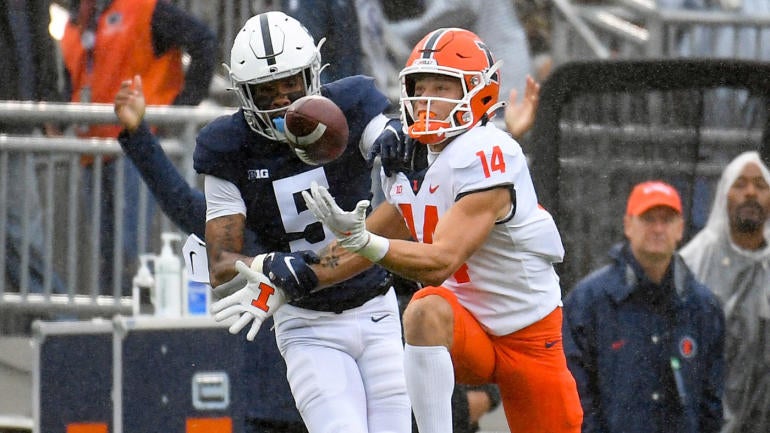
Illinois upset No. 7 Penn State, 20-18, in the first nine-overtime game in FBS history on Saturday afternoon. After both teams struggled to put points on the board during regulation, the game went to overtime tied 10-10. They traded field goals in the first two overtime periods before going to a third overtime where college football's new overtime rules took over.
The Illini and Nittany Lions were forced to trade two-point conversion attempts starting in the third overtime. They went five straight periods without either team finding the end zone before both scored in the eighth overtime. Illinois converted to open the ninth overtime, and Penn State was unable to match the visitors on its final attempt.
It's a rule change was designed with player safety in mind. The goal was to ensure there would be fewer plays and opportunities for injury once regulation expired. What the rule makers did not count on was a couple offenses too inept to score.
We have a decision.@IlliniFootball upsets No. 7 Penn State in an FBS-record 9⃣(!) OTs. pic.twitter.com/I23CJ2ohIM
— Big Ten Network (@BigTenNetwork) October 23, 2021
By the time the game came to an end, Illinois was down to its No. 2 quarterback Brandon Peters as starter Art Sitkowski was indeed injured in overtime. It was also without its top two running backs. Still, despite the crazy situation, it's hard to argue the Illini didn't deserve to win the game.
Illinois finished with 395 yards of offense, holding Penn State to 227 yards on the afternoon. The Illini also had two running backs finish with over 100 yards rushing as Chase Brown rushed for 223 yards and a score and Josh McCray posted 142 yards.
The win improves Illinois to 3-5 and drops Penn State to 5-2. The Nittany Lions are now on the outside of the College Football Playoff conversation, suffering a difficult loss to an unranked opponent just one week before Penn State visits No. 5 Ohio State for a rivalry showdown.
Awful look for Penn State
The Nittany Lions were 24-point favorites in this game, and losing to a 2-5 team as a 24-point favorite is never good. It's even worse when you're coming off a bye and had an extra week to prepare for the game. The Nittany Lions were off last week following a loss to Iowa two weeks ago and had extra time to prepare for an Illini team that lost 24-0 to Wisconsin its last time out.
All that preparation resulted in 18 points, 227 yards of offense and 3.6 yards per play. Granted, quarterback Sean Clifford was clearly less than 100%. Clifford left the Iowa loss early due to injury but was deemed healthy enough to play Saturday. Unfortunately, you could see whenever he threw a pass or took a hit that he was feeling the effects, which helps explain why he could only complete 19 of 34 passes for 165 yards.
Dotson resumes business as usual 💼 😤.@PennStateFball // @H55ZY pic.twitter.com/ZxSYCqTcHj
— Big Ten Network (@BigTenNetwork) October 23, 2021
Still, there's no excuse for Penn State losing this game and looking this unprepared. Illinois turned the ball over three times in the game, including twice in its own territory, but Penn State couldn't take advantage. It managed one field goal off the turnovers, and those were the only points the Nittany Lions picked up in two trips into the red zone.
You can't help but believe Penn State used its bye as extra time to prepare for next week's game against Ohio State rather than the opponent it had first.
You must be able to run the ball
After Penn State knocked off Auburn 28-20 earlier this season, I wrote that Penn State's rushing attack was a concern. After rushing for only 2.8 yards per carry against Wisconsin, the Nittany Lions managed only 2.7 per carry against Auburn. "I can't help but believe there's going to be a time when it needs but will be unable to run, and it'll cost PSU a game." Yes, I'm quoting myself.
Well, it's cost PSU twice now. The Nittany Lions were held to 3.2 yards per carry in their loss to Iowa, and Saturday, the Illini held them to 2.1 yards per carry. With Clifford banged up (and out against Iowa), Penn State needed a run game to lean on to help move the ball, and it never showed up. Being able to run the ball would've come in handy during all those overtimes when Penn State couldn't score.
Illinois won despite throwing for 38 yards
Not only did Illinois go on the road and upset a top-10 team, it did so despite passing for only 38 yards and finishing -3 in the turnover column. How'd the Illini do it? By running the dang ball. Brown and McCray rushed for over 100 yards with Brown going over 200 yards for the second time this season. Coming into the game, only Wisconsin's Chez Mellusi and Auburn's Tank Bigsby managed to crack the 100-yard barrier against this Penn State defense. It was somewhat obvious that Penn State missed defensive tackle P.J. Mustipher in the middle of its line.
Of course, Illinois was able to run the ball so successfully because it had no other choice. The Illini have such little faith in their quarterbacks -- Sitkowski started, but Peters has started most of Illinois' games this season -- that on a third-and-6 in overtime, the Illini opted to run a double-reverse pass with their wide receiver throwing to Sitkowski.
Whenever a team would rather have a wide receiver throwing a third-down pass than its quarterback, well, it tells you everything you need to know about the team's level of confidence in its quarterback.
New overtime rules are a failure
This isn't a complaint. I'm not commenting the entertainment value of the format. I'm simply saying, well, it's stupid to end a football game in this matter. Even if both teams converted their attempts, it would've been just as stupid to keep going. It's a rule implemented for honorable reasons, but there was nothing wrong with the overtime format college football was already using.
Extended overtimes were so few and far between, that the sport -- as well-intentioned as it may have been -- fixed a problem that did not need a solution. There were only six seven-overtime games in FBS history entering Saturday. Most get ended after a couple periods with outliers extermely rare.
7⃣ OTs, anyone?@IlliniFootball and @PennStateFball play on at Beaver Stadium. pic.twitter.com/8kATQ131x7
— Big Ten Network (@BigTenNetwork) October 23, 2021





















